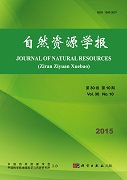Resource Economics
ZHANG Yao-yu, CHEN Hui-guang, SONG Lu-yi, CHEN Li-gen
Based on the city size, this paper analyzed the difference in local government’s land fiscal behavior. On the basis of the existing research, the paper induced three main effects which might explain the government’s behavior on land finance. The three effects were urban expansion effect, urban population agglomeration effect, and urban industrial scale and structural adjustment effect. Correspondently, three theoretical hypotheses about the effects were proposed and tested. Using the panel data of 11 years which contain 243 prefecture-level cities, it empirically tested the fixed effect model, and the results showed that there were different driving forces for different size of cities behind their land fiscal behaviors. Firstly, the urban expansion effect had more powerful influence in small cities and medium-sized cities, comparing with big cities and the megacities. Secondly, the urban population gathering effect is effective in all city groups. The relationship between the population and land finance can be described by a U-shaped curve, which means the urban population gathering effect has an inflexion point. Comparing the inflexion point with the median, it could be found that the median was bigger than the inflexion point in medium-sized cities (73.71×104>62.41×104), big cities (147.07×104>66.92×104), and megacities (499.90×104>384.24×104). Only in the group of small cities, its inflexion point is bigger than the median (51.81×104>42.74×104). Thirdly, the urban industrial scale and structural adjustment effect were complex. Generally, the third industry would push land fiscal revenue in all except big cities, while the second industry would push land fiscal revenue only in big cities. The second industry would decrease land fiscal revenue in small cities and medium-sized cities. The industrial structural adjustment in small and medium cities would decrease land fiscal revenue, while it would promote land fiscal revenue growth in big cities. Therefore, different policies should be made for different cities according to the governance of land fiscal revenue. Special attention should be paid to the control policies, such as land policy, population policy, household registering policy, and industrial policy. For a small city, the policy should focus on decreasing the urban expansion effect and increasing the population agglomeration effect. For a medium-sized city, the policy should keep land supply structure in addition to controlling the land size. For big cities and megacities, the policy of governance should contain land policy and population policy, and keep a reasonable and orderly rate of the immigration.
